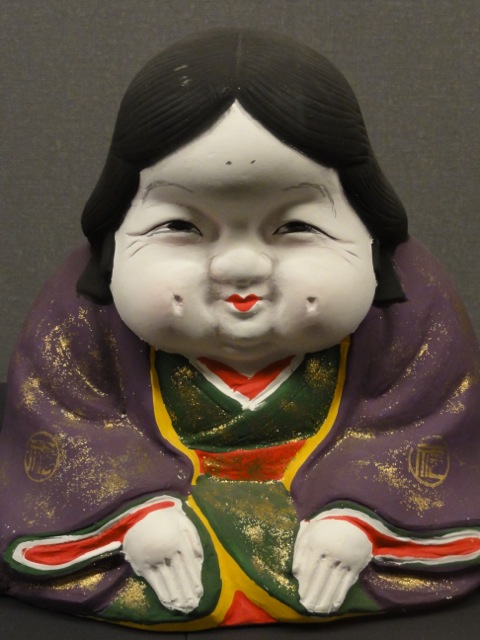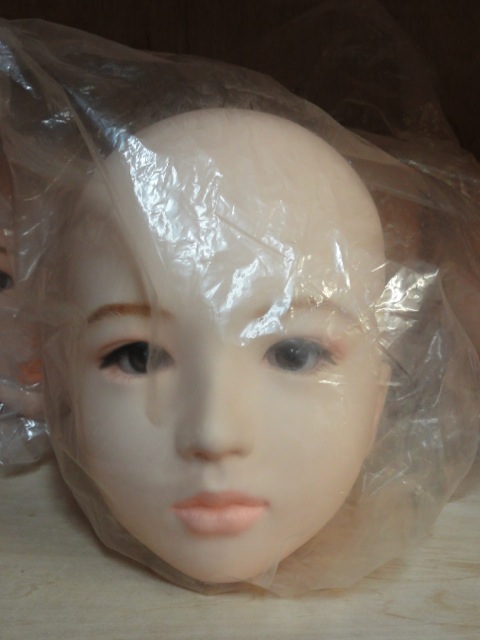One of the joys of writing this blog is the chance to interact with readers, some of whom are able to make personal contact when visiting Kyoto. One such person is Agnes Giard, whose research topic opens up new ways of looking at the use of dolls and containers in Shinto.
**********************************************************************************
 1) What is your area of research and your interest in Shinto?
1) What is your area of research and your interest in Shinto?
I am a Phd student at the University of Paris 8 Nanterre-La Défense, conducting anthropology research focusing on ‘simulated humanity and the effect of presence in the anthropomorphic objects in Japan’. My research targets the market of life-size dolls equipped with articulated skeleton and flesh more real than nature. But in order to understand how Japanese artists and engineers elaborate replicas of human beings, I also have to to study the meaning of Japanese anthropomorphic objects… which led me directly to the use of katashiro, nademono, hitogata and other human-shaped objects involved in the worship of kami.
My project relates to these “artificial life” systems that some Japanese companies and laboratories are currently producing, establishing themselves as world leaders in this pioneer research field. Most of the androids produced in Japan are designed to create a humanlike presence.
To understand how Japanese succeed in creating life and consciousness out of inanimate objects, I conduct interviews with Japanese historians, architects, ethnologists, philosophers, artists or priests about the concepts of «box», «mirror», «soul», «empty space», «things that can not be seen», «secret», etc. My goal is to understand the way interaction with inanimate objects can be made possible in Japan, through dolls developed as “vacant vehicles”.
2) Please tell us something about the books you have published and the media you have written for.
As a journalist, I work for the daily newspaper Liberation: I am in charge of a bi-weekly chronicle (Les 400 culs) dedicated to anthropology of sexuality. I also used to collaborate with Le Monde, Marie-Claire, Cosmopolitan, and 30 other French magazines or newspapers. As an author, I have published 4 books about Japanese culture, with illustrations and participation of many contemporary Japanese artists such as Tadanori Yokoo, Makoto Aida, etc.
The books I have written are Love stories in Japan: From original myths to contemporary fables; Objects of Desire in Japan; Dictionary of love and pleasure in Japan; Erotic fantasy in Japan. My first book was also published in Japan as Fetish Mode, Wailea publishing (Tôkyô, 2003).
Also, I take part in conferences, I write introduction for books related to Japanese culture, I participate in workshops related to Japanese aesthetics, I organized an art exhibition about Japanese eroticism. In brief, I do my best to enhance cultural exchanges between France and Japan.
3) How did you first become interested in these subjects?
I was 9 years old when I saw Captain Harlock, Leiji Matsumoto’s anime, on TV. I had been raised in dualism. With Captain Harlock and his punk attitude, I started understanding that you have to achieve yourself through constant criticism of what is right or beautiful. Criticism is much like purifying yourself.
Then, I started reading authors such as Kenji Miyazawa, Chikamatsu Monzaemon, Yukio Mishima, Yasunari Kawabata, Jun’Ichiro Tanizaki, Kenzaburo Oe, Ono no Komachi, Murasaki Shikibu, Kobo Abe, Edogawa Ranpo and Akiyuki Nosaka (to mention just a few of my favorite writers).
4) How good is your Japanese, and how do you manage to do your research given the language difficulties?
I just achieved my 3rd year as student, but it’s still difficult for me to conduct interviews in Japanese, so I ask for the help of translators, in order not to miss nuances of the beautiful Japanese language.
5) What are some of the biggest surprises you’ve come across in your research?
I noticed that the Japanese engineers who improve, year after year, the realistic doll replicas seem to be very cautious not to “imitate” but to “represent” human beings, as if the best way to create a doll upgraded with consciousness was to make her look obviously empty and somehow fake. This topic is precisely the one I would like to develop with the help of researchers on religion; it seems that absence is the closest thing to human presence.
In robotic laboratories, the humanoid machines are programmed to perform a pattern of movements such as eye blinking, in order to mimicry nonverbal communication. But these mechanical conventions induce us to look at the machine as if it was a mere puppet, gesticulating in a nonsensical way.
In love dolls, engineers and artists create them still, silent and non-expressive. The face of these dolls are introspective, their emotions hidden behind an enigmatic mask, and they ignore you. This is precisely what allows humans to have a strong emotional bond with the artifacts.
In other words, evidence appears that there is a troubling correlation between the growing humanoid industry and these dolls that are made to fulfill the need for a relationship. These “awaiting creatures” are now getting public attention through increased media exposure, but, to my mind, they correspond to something that already exists in Japan: substitute forms.
My goal is to understand how, in Japan, inanimate objects can get a soul and identity. Through their attempts to create humanoid products, Japanese engineers and artists refine our definition of what a human being is. “In copying ourselves, we come to know ourselves.” By studying how dolls are imbued with the ability to interact, I hope to open a new field of reflection about the borderline between human beings and “things”.
6) What are your plans for the future?
To go on writing books and deepening my understanding of Japanese culture.

The plump, cheerful and good-hearted Otafuku, sometimes a fertility symbol at Shinto shrines, is often associated with ribaldry. Photo credits : Museum of dolls, Fukuyama (photo : Giard). (for more about her, see https://www.greenshinto.com/2012/03/25/otafuku-and-uzume/)



Leave a Reply